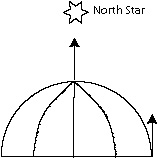OVERVIEW – EARTH SIZE AND SHAPE
How can we study the earth – we live on the surface and can only penetrate
by drilling a little ways. So our studies are rather indirect.
I. HOW DO WE KNOW THE EARTH IS APPROXIMATELY A SPHERE?
1) Circumnavigation alone doesn’t prove it – need all paths to be of approximately the same length.
2) Objects vanish below horizon as they move away.
3) The North star is overhead at the pole, but on the horizon at equator.
This is the same for all meridians
4) During a lunar eclipse – all shadows cast on moon by the earth
are arcs of circles.
II. HOW LARGE IS THE EARTH? HOW CAN WE MEASURE IT?
In a famous error, Columbus used a too-small value for the distance (number of km) in a degree wrong, which convinced him the earth was much smaller than it really was, making it only a few weeks sail from Europe to Asia
However, long before (200 BC) Eratosthenes measured the earth’s radius by considering the elevation at the sun on the same day in two places
The sun cast its shadow into a well in Synere, but made an angle of 7 degrees and 12 minutes with the vertical at Alexandria (Egypt), 5000 stadia (the unit that became our “stadium”) away
5000 statida /circumference = 7 degrees 12 minutes/360 degrees
circumference = 250,000 stadia = 46,250 km = 2 p radius
This gives the radius = 7,361 km, close to the modern value = 6371 km
This is a value you’re expected to know!
This, together with the length of the day (24 hrs) and year (365 days) are the first important earth parameters to be determined. Note that these must be derived from observations!


